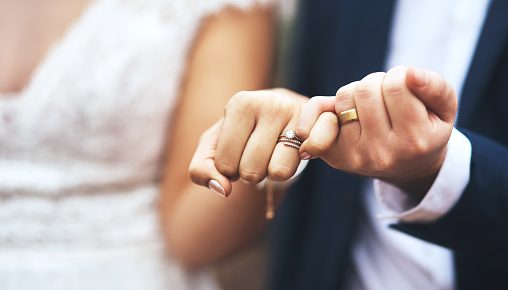
Has getting married these days become a secular matter rather than a religious one? The latest figures released by the Office for National Statistics would certainly suggest so. In 2018, barely a fifth of weddings in England and Wales were classified as ‘religious’ rather than ‘civil’, the lowest on record. Just twenty-five years ago, by contrast, that figure stood at fifty percent.
But the statistics don’t tell the whole story. Both today and in the past, there have always been couples who’ve chosen to go through a purely religious marriage ceremony, either before, after, or even instead of a legally recognised one. And these religious ceremonies are invisible to ONS statisticians.
Before 1836, the law only made provision for couples to marry according to the rites of the Anglican church. While Quaker and Jewish weddings were exempted, Catholics, Nonconformists, and any adherents of other faiths (they were few indeed) had no choice but to marry in the parish church if they wanted their marriages to be legally recognised. While most complied, the plight of the growing number of Irish immigrants whose purely Catholic ceremonies went unrecognised by the law became a source of concern, and this was one of the factors that eventually led to reform.
How the law was reformed is important, because the legacy of it is still being felt today. The Marriage Act 1836 allowed Nonconformists and Catholics to marry according to their own rites – but hedged this privilege around with certain conditions. They had to give notice to a new-fangled ‘civil registrar’, and the wedding itself had include certain prescribed words. It also had to take place in a duly registered place of worship. It was this need for registration which meant that, in practice, not all Nonconformists and Catholics had the option of getting married where they worshipped. With only a relatively small proportion of the thousands of chapels in England and Wales actually being registered for weddings, many couples took up the other new option established by the Act — marriage in a register office — and enjoyed a separate religious ceremony of their choosing.
The 1836 Act also established the first formal framework for Quaker and Jewish weddings, but many of the Jewish refugees arriving from Eastern Europe in the late nineteenth century didn’t realise the need for formalities and married only in religious ceremonies unrecognised by the law. From that same period on, England and Wales also became home to an increasing number of Muslims, Sikhs, and Hindus. In principle, their places of worship could be registered for weddings (an earlier requirement that they had to be Christian had been removed in 1855). In practice, though, it was not until 1920 that the first mosque was registered, and not until the 1960s that any gurdwaras or temples were registered. Until that time, Muslim, Hindu, and Sikh couples either had two ceremonies — one civil, one religious — or, often, just a single, legally unrecognised religious ceremony.
Fast-forward to today, and — astonishingly — virtually all of the restrictions established by the 1836 Act as to where religious marriages can be celebrated are still in place. The options open for civil weddings, though, have been transformed. The Marriage Act 1994 allowed civil weddings to be celebrated in a wide variety of venues, such as hotels and stately homes, after approval by the local council. Such venues have the obvious advantage of being able to host the wedding reception as well. Small wonder, then, that so many couples are choosing the option of marrying in a civil ceremony on ‘approved premises’.
But the fact that the overwhelming majority of couples now choose to marry in a civil ceremony on approved premises doesn’t mean that this would have been their preference. With still only a minority of non-Christian places of worship registered for weddings, even couples for whom religious belief and practice are a fundamental part of life find themselves tying the legal knot in a civil ceremony while organising an additional — and personally more meaningful — religious ceremony.
So the bare statistics produced by the ONS only tell us how couples are choosing between the available options. They do not tell us how these couples might have wanted to marry if other options had been available to them.
Latest Comments
Have your say!